Paper Menu >>
Journal Menu >>
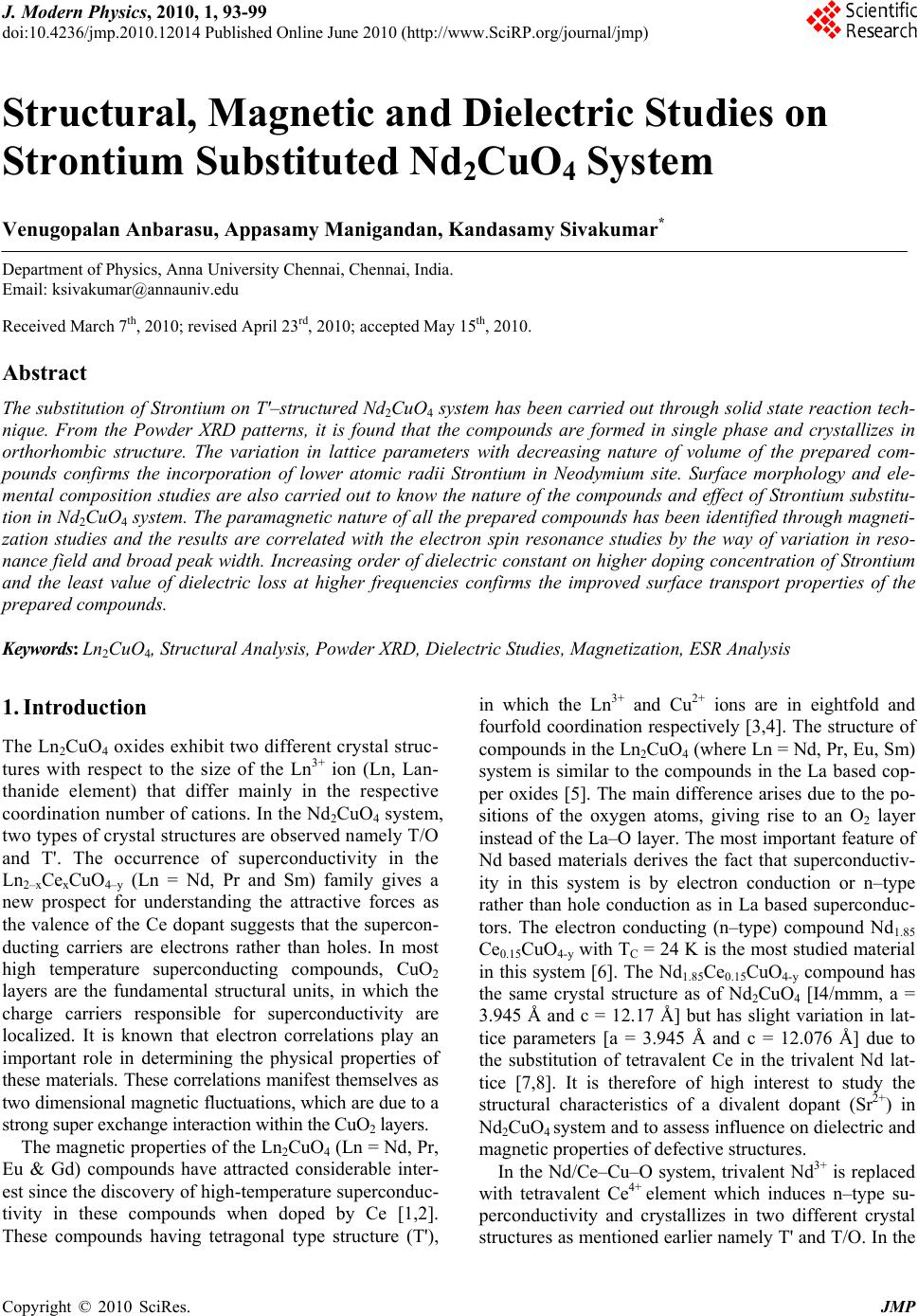 J. Modern Physics, 2010, 1, 93-99 doi:10.4236/jmp.2010.12014 Published Online June 2010 (http://www.SciRP.org/journal/jmp) Copyright © 2010 SciRes. JMP Structural, Magnetic and Dielectric Studies on Strontium Substituted Nd2CuO4 System Venugopalan Anbarasu, Appasamy Manigandan, Kandasamy Sivakumar* Department of Physics, Anna University Chennai, Chennai, India. Email: ksivakumar@annauniv.edu Received March 7th, 2010; revised April 23rd, 2010; accepted May 15th, 2010. Abstract The substitution of Strontium on T'–structured Nd2CuO4 system has been carried out through solid state reaction tech- nique. From the Powder XRD patterns, it is found that the compounds are formed in single phase and crystallizes in orthorhombic structure. The variation in lattice parameters with decreasing nature of volume of the prepared com- pounds confirms the incorporation of lower atomic radii Strontium in Neodymium site. Surface morphology and ele- mental composition studies are also carried out to know the nature of the compounds and effect of Strontium substitu- tion in Nd2CuO4 system. The paramagnetic nature of all the prepared compounds has been identified through magneti- zation studies and the results are correlated with the electron spin resonance studies by the way of variation in reso- nance field and broad peak width. Increasing order of dielectric constant on higher doping concentration of Strontium and the least value of dielectric loss at higher frequencies confirms the improved surface transport properties of the prepared compounds. Keywords: Ln2CuO4, Structural Analysis, Powder XRD, Dielectric Studies, Magnetization, ESR Analysis 1. Introduction The Ln2Cu O4 oxides exhibit two different crystal struc- tures with respect to the size of the Ln3+ ion (Ln, Lan- thanide element) that differ mainly in the respective coordination number of cations. In the Nd2CuO4 system, two types of crystal structures are observed namely T/O and T'. The occurrence of superconductivity in the Ln2–xCexCuO4–y (Ln = Nd, Pr and Sm) family gives a new prospect for understanding the attractive forces as the valence of the Ce dopant suggests that the supercon- ducting carriers are electrons rather than holes. In most high temperature superconducting compounds, CuO2 layers are the fundamental structural units, in which the charge carriers responsible for superconductivity are localized. It is known that electron correlations play an important role in determining the physical properties of these materials. These correlations manifest themselves as two dimensional magnetic fluctuations, which are due to a strong super exchange interaction within the CuO2 layers. The magnetic properties of the Ln2CuO4 (Ln = Nd, Pr, Eu & Gd) compounds have attracted considerable inter- est since the discovery of high-temperature superconduc- tivity in these compounds when doped by Ce [1,2]. These compounds having tetragonal type structure (T'), in which the Ln3+ and Cu2+ ions are in eightfold and fourfold coordination respectively [3,4]. The structure of compounds in the Ln2CuO4 (where Ln = Nd, Pr, Eu, Sm) system is similar to the compounds in the La based cop- per oxides [5]. The main difference arises due to the po- sitions of the oxygen atoms, giving rise to an O2 layer instead of the La–O layer. The most important feature of Nd based materials derives the fact that superconductiv- ity in this system is by electron conduction or n–type rather than hole conduction as in La based superconduc- tors. The electron conducting (n–type) compound Nd1.85 Ce0.15CuO4-y with TC = 24 K is the most studied material in this system [6]. The Nd1.85Ce0.15CuO4-y compound has the same crystal structure as of Nd2CuO4 [I4/mmm, a = 3.945 Å and c = 12.17 Å] but has slight variation in lat- tice parameters [a = 3.945 Å and c = 12.076 Å] due to the substitution of tetravalent Ce in the trivalent Nd lat- tice [7,8]. It is therefore of high interest to study the structural characteristics of a divalent dopant (Sr2+) in Nd2CuO4 system and to assess influence on dielectric and magnetic properties of defective structures. In the Nd/Ce–Cu–O system, trivalent Nd3+ is replaced with tetravalent Ce4+ element which induces n–type su- perconductivity and crystallizes in two different crystal structures as mentioned earlier namely T' and T/O. In the 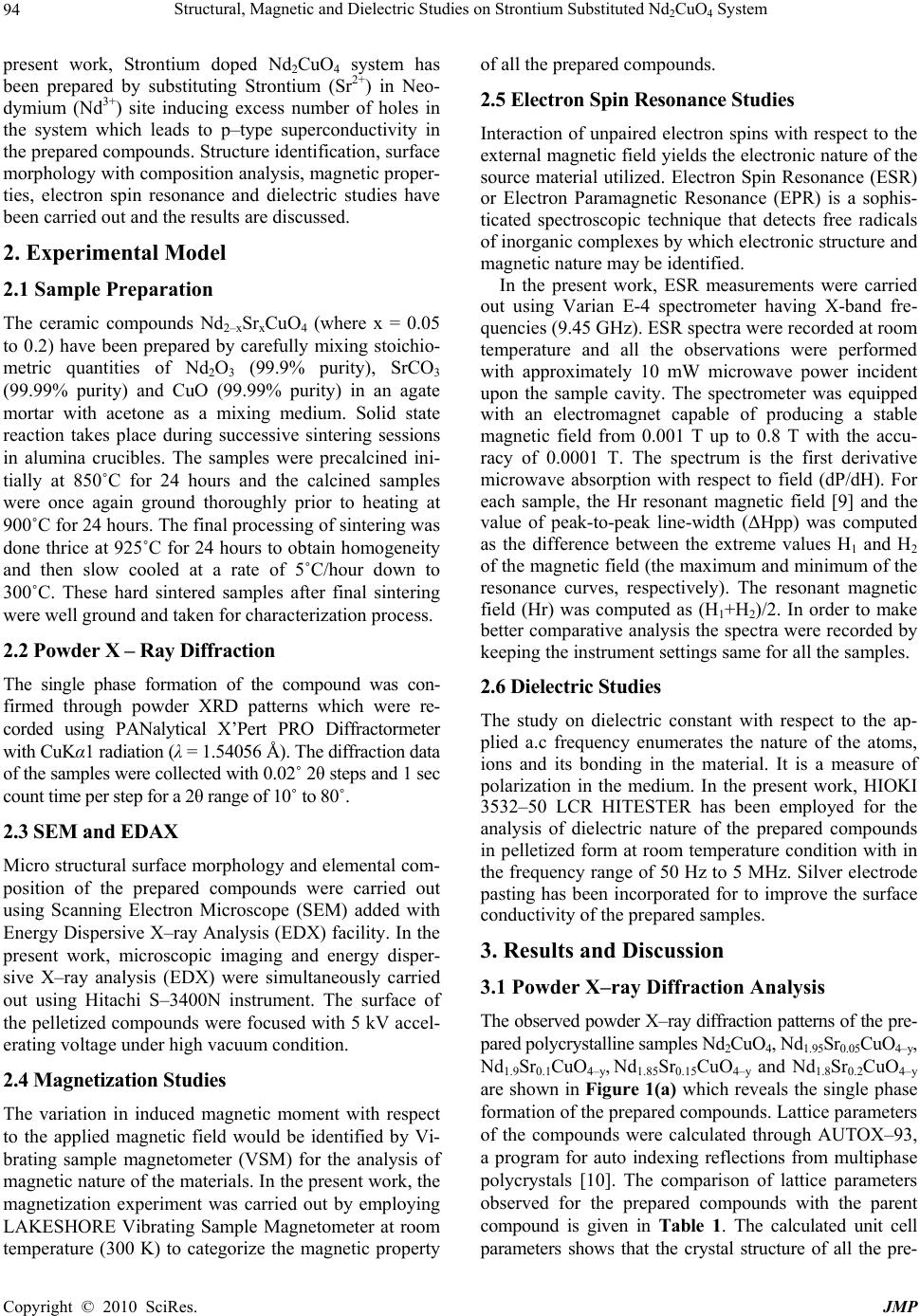 Structural, Magnetic and Dielectric Studies on Strontium Substituted Nd2CuO4 System Copyright © 2010 SciRes. JMP 94 present work, Strontium doped Nd2CuO4 system has been prepared by substituting Strontium (Sr2+) in Neo- dymium (Nd3+) site inducing excess number of holes in the system which leads to p–type superconductivity in the prepared compounds. Structure identification, surface morphology with composition analysis, magnetic proper- ties, electron spin resonance and dielectric studies have been carried out and the results are discussed. 2. Experimental Model 2.1 Sample Preparation The ceramic compounds Nd2–xSrxCuO4 (where x = 0.05 to 0.2) have been prepared by carefully mixing stoichio- metric quantities of Nd2O3 (99.9% purity), SrCO3 (99.99% purity) and CuO (99.99% purity) in an agate mortar with acetone as a mixing medium. Solid state reaction takes place during successive sintering sessions in alumina crucibles. The samples were precalcined ini- tially at 850˚C for 24 hours and the calcined samples were once again ground thoroughly prior to heating at 900˚C for 24 hours. The final processing of sintering was done thrice at 925˚C for 24 hours to obtain homogeneity and then slow cooled at a rate of 5˚C/hour down to 300˚C. These hard sintered samples after final sintering were well ground and taken for characterization process. 2.2 Powder X – Ray Diffraction The single phase formation of the compound was con- firmed through powder XRD patterns which were re- corded using PANalytical X’Pert PRO Diffractormeter with CuKα1 radiation (λ = 1.54056 Å). The diffraction data of the samples were collected with 0.02˚ 2θ steps and 1 sec count time per step for a 2θ range of 10˚ to 80˚. 2.3 SEM and EDAX Micro structural surface morphology and elemental com- position of the prepared compounds were carried out using Scanning Electron Microscope (SEM) added with Energy Dispersive X–ray Analysis (EDX) facility. In the present work, microscopic imaging and energy disper- sive X–ray analysis (EDX) were simultaneously carried out using Hitachi S–3400N instrument. The surface of the pelletized compounds were focused with 5 kV accel- erating voltage under high vacuum condition. 2.4 Magnetization Studies The variation in induced magnetic moment with respect to the applied magnetic field would be identified by Vi- brating sample magnetometer (VSM) for the analysis of magnetic nature of the materials. In the present work, the magnetization experiment was carried out by employing LAKESHORE Vibrating Sample Magnetometer at room temperature (300 K) to categorize the magnetic property of all the prepared compounds. 2.5 Electron Spin Resonance Studies Interaction of unpaired electron spins with respect to the external magnetic field yields the electronic nature of the source material utilized. Electron Spin Resonance (ESR) or Electron Paramagnetic Resonance (EPR) is a sophis- ticated spectroscopic technique that detects free radicals of inorganic complexes by which electronic structure and magnetic nature may be identified. In the present work, ESR measurements were carried out using Varian E-4 spectrometer having X-band fre- quencies (9.45 GHz). ESR spectra were recorded at room temperature and all the observations were performed with approximately 10 mW microwave power incident upon the sample cavity. The spectrometer was equipped with an electromagnet capable of producing a stable magnetic field from 0.001 T up to 0.8 T with the accu- racy of 0.0001 T. The spectrum is the first derivative microwave absorption with respect to field (dP/dH). For each sample, the Hr resonant magnetic field [9] and the value of peak-to-peak line-width (ΔHpp) was computed as the difference between the extreme values H1 and H2 of the magnetic field (the maximum and minimum of the resonance curves, respectively). The resonant magnetic field (Hr) was computed as (H1+H2)/2. In order to make better comparative analysis the spectra were recorded by keeping the instrument settings same for all the samples. 2.6 Dielectric Studies The study on dielectric constant with respect to the ap- plied a.c frequency enumerates the nature of the atoms, ions and its bonding in the material. It is a measure of polarization in the medium. In the present work, HIOKI 3532–50 LCR HITESTER has been employed for the analysis of dielectric nature of the prepared compounds in pelletized form at room temperature condition with in the frequency range of 50 Hz to 5 MHz. Silver electrode pasting has been incorporated for to improve the surface conductivity of the prepared samples. 3. Results and Discussion 3.1 Powder X–ray Diffraction Analysis The observed powder X–ray diffraction patterns of the pre- pared polycrystalline samples Nd2CuO4, Nd1.95Sr0.05CuO4–y, Nd1.9Sr0.1CuO4–y, Nd1.85Sr0.15CuO4–y and Nd1.8Sr0.2CuO4–y are shown in Figure 1(a) which reveals the single phase formation of the prepared compounds. Lattice parameters of the compounds were calculated through AUTOX–93, a program for auto indexing reflections from multiphase polycrystals [10]. The comparison of lattice parameters observed for the prepared compounds with the parent compound is given in Table 1. The calculated unit cell parameters shows that the crystal structure of all the pre-  Structural, Magnetic and Dielectric Studies on Strontium Substituted Nd2CuO4 System Copyright © 2010 SciRes. JMP 95 pared compounds vary from the parent tetragonal structure to orthorhombic with least difference in magnitudes. Fig- ures 1(b) and 1(c) show the shift in the higher intensity peaks of the prepared compounds with the formation of newer peaks (marked in * symbol) which reveals variation in the crystal system and lattice parameters of the prepared compounds. Due to the substitution of lower atomic radii element (Sr – 2.45 Å) in the higher atomic radii element site (Nd – 2.64 Å), the volume of the prepared compounds decreases with respect to the parent compound. Hence from the XRD patterns, it may be concluded that the Neodymium site is partly replaced with the Strontium atom. 3.2 Surface Morphology and Elemental Analysis The surface morphology and crystallization nature of the samples were analyzed by scanning electron microscope images and the observed images for the prepared com- pounds are shown in Figure 2. In the present work, the pelletized samples annealed at 925˚C were used for the surface morphology analysis. The images of the inner portion of the pellets show that all the compounds have regular crystallites with the size in the micrometer range. The regular arrangement of particles reveals that the compounds were formed in well crystalline nature without clustering. Some amount of agglomeration of particles in the parent compound may be due to low melting point of the same as compared with Strontium substituted compounds. The elemental composition analysis confirms the presence of Strontium in the host matrix of Nd2CuO4 system with increasing concentrations in the samples. The decrease in the con- centration of Nd reveals the replacement of trivalent Neodymium with divalent Strontium element. 3.3 Magnetization Analysis The observed magnetization nature of the prepared compounds is shown in Figure 3. It is observed that the intensity of magnetization varies linearly with the ap- plied magnetic field for all the prepared compounds which reveals the paramagnetic nature of the resultant Table 1. Comparative statement of lattice parameters ob- served for parent and substituted compounds Compounda (Å) b (Å) c (Å) Volum e (Å3) Syst em* Nd2CuO4 3.945 3.945 12.17 189.2 T Nd1.95Sr0.05 CuO4-y 3.945(3) 3.927(6)12.16(1)188.6 O Nd1.9Sr0.1 CuO4-y 3.826(5) 3.943(3)12.19(1)184.1 O Nd1.85Sr0.15 CuO4–y 3.832(3) 3.946(2)12.18(6)184.3 O Nd1.8Sr0.2 CuO4–y 3.897(6) 3.901(6)12.09(1)183.9 O * T – Tetragonal and O – Orthorhombic (a) (b) (c) Figure 1. (a) Powder X–Ray Diffraction patterns of the prepared compounds; (b) Comparison of diffraction pat- terns of the major intensity peak; (c) Comparison of dif- fraction patterns of the 50% intensity peak 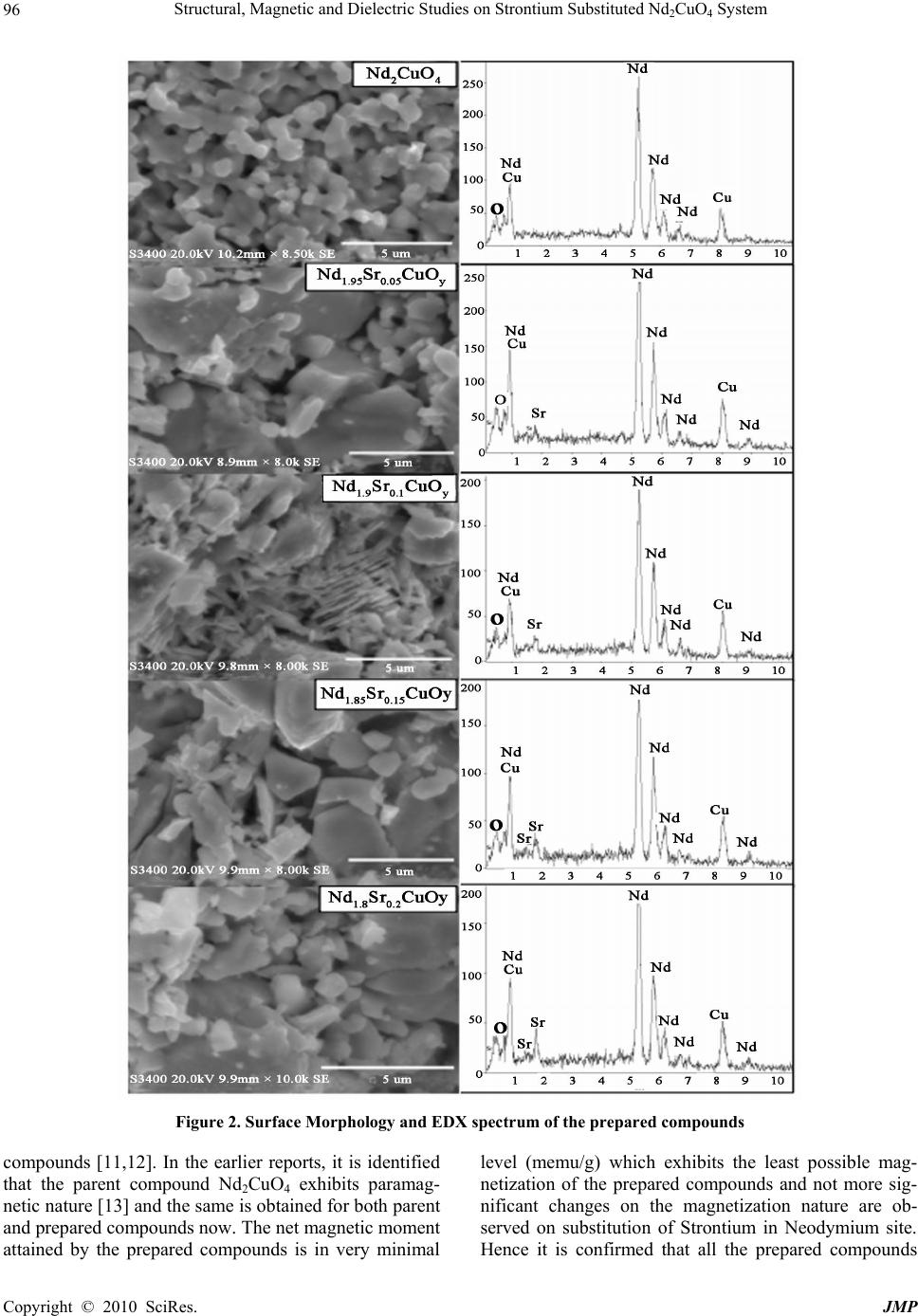 Structural, Magnetic and Dielectric Studies on Strontium Substituted Nd2CuO4 System Copyright © 2010 SciRes. JMP 96 Figure 2. Surface Morphology and EDX spectrum of the prepared compounds compounds [11,12]. In the earlier reports, it is identified that the parent compound Nd2CuO4 exhibits paramag- netic nature [13] and the same is obtained for both parent and prepared compounds now. The net magnetic moment attained by the prepared compounds is in very minimal level (memu/g) which exhibits the least possible mag- netization of the prepared compounds and not more sig- nificant changes on the magnetization nature are ob- served on substitution of Strontium in Neodymium site. Hence it is confirmed that all the prepared compounds 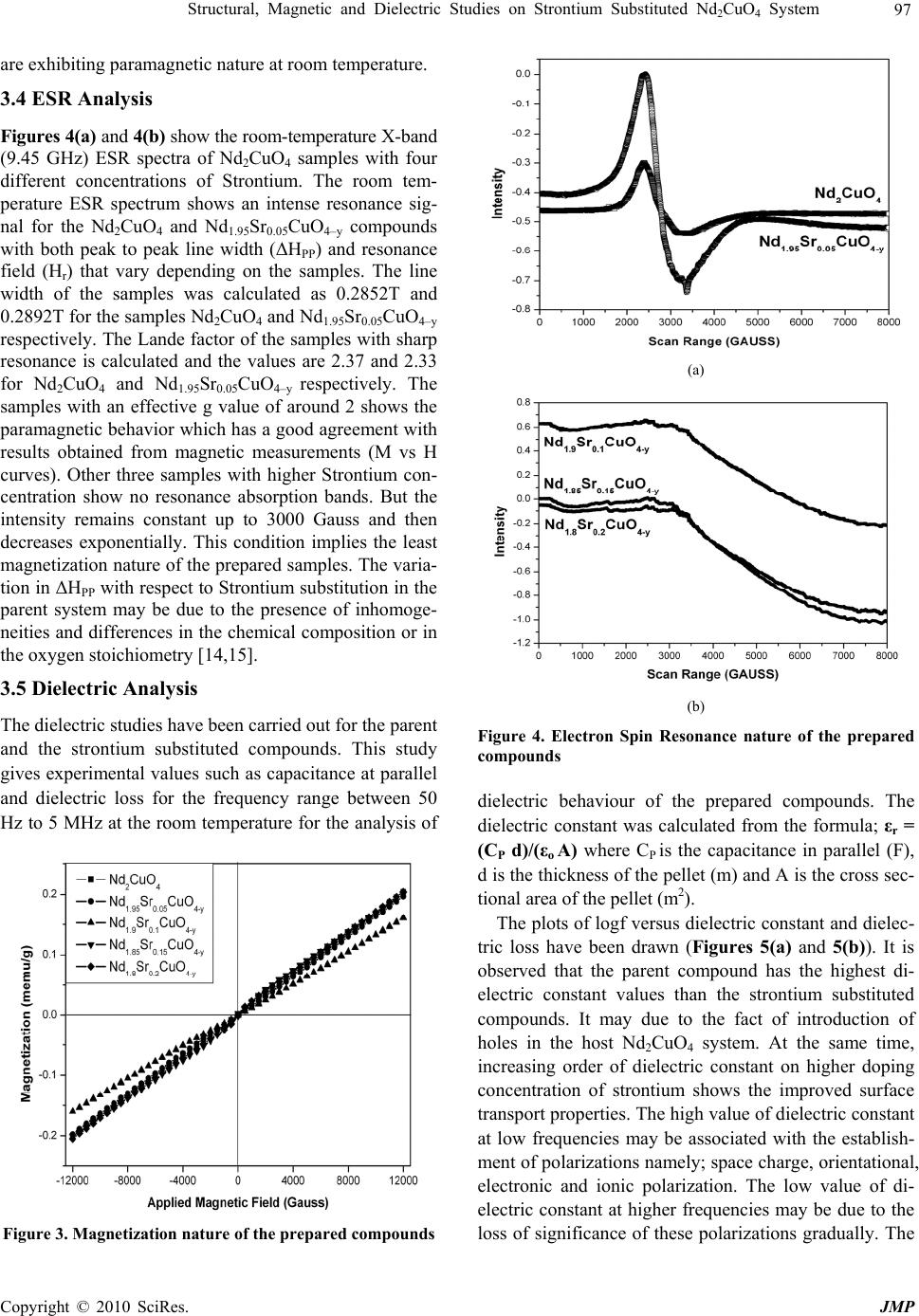 Structural, Magnetic and Dielectric Studies on Strontium Substituted Nd2CuO4 System Copyright © 2010 SciRes. JMP 97 are exhibiting paramagnetic nature at room temperature. 3.4 ESR Analysis Figures 4(a) and 4(b) show the room-temperature X-band (9.45 GHz) ESR spectra of Nd2CuO4 samples with four different concentrations of Strontium. The room tem- perature ESR spectrum shows an intense resonance sig- nal for the Nd2CuO4 and Nd1.95Sr0.05CuO4–y compounds with both peak to peak line width (ΔHPP) and resonance field (Hr) that vary depending on the samples. The line width of the samples was calculated as 0.2852T and 0.2892T for the samples Nd2CuO4 and Nd1.95Sr0.05CuO4–y respectively. The Lande factor of the samples with sharp resonance is calculated and the values are 2.37 and 2.33 for Nd2CuO4 and Nd1.95Sr0.05CuO4–y respectively. The samples with an effective g value of around 2 shows the paramagnetic behavior which has a good agreement with results obtained from magnetic measurements (M vs H curves). Other three samples with higher Strontium con- centration show no resonance absorption bands. But the intensity remains constant up to 3000 Gauss and then decreases exponentially. This condition implies the least magnetization nature of the prepared samples. The varia- tion in ΔHPP with respect to Strontium substitution in the parent system may be due to the presence of inhomoge- neities and differences in the chemical composition or in the oxygen stoichiometry [14,15]. 3.5 Dielectric Analysis The dielectric studies have been carried out for the parent and the strontium substituted compounds. This study gives experimental values such as capacitance at parallel and dielectric loss for the frequency range between 50 Hz to 5 MHz at the room temperature for the analysis of Figure 3. Magnetization nature of the prepared compounds (a) (b) Figure 4. Electron Spin Resonance nature of the prepared compounds dielectric behaviour of the prepared compounds. The dielectric constant was calculated from the formula; εr = (CP d)/(εo A) where CP is the capacitance in parallel (F), d is the thickness of the pellet (m) and A is the cross sec- tional area of the pellet (m2). The plots of logf versus dielectric constant and dielec- tric loss have been drawn (Figures 5(a) and 5(b)). It is observed that the parent compound has the highest di- electric constant values than the strontium substituted compounds. It may due to the fact of introduction of holes in the host Nd2CuO4 system. At the same time, increasing order of dielectric constant on higher doping concentration of strontium shows the improved surface transport properties. The high value of dielectric constant at low frequencies may be associated with the establish- ment of polarizations namely; space charge, orientational, electronic and ionic polarization. The low value of di- electric constant at higher frequencies may be due to the loss of significance of these polarizations gradually. The 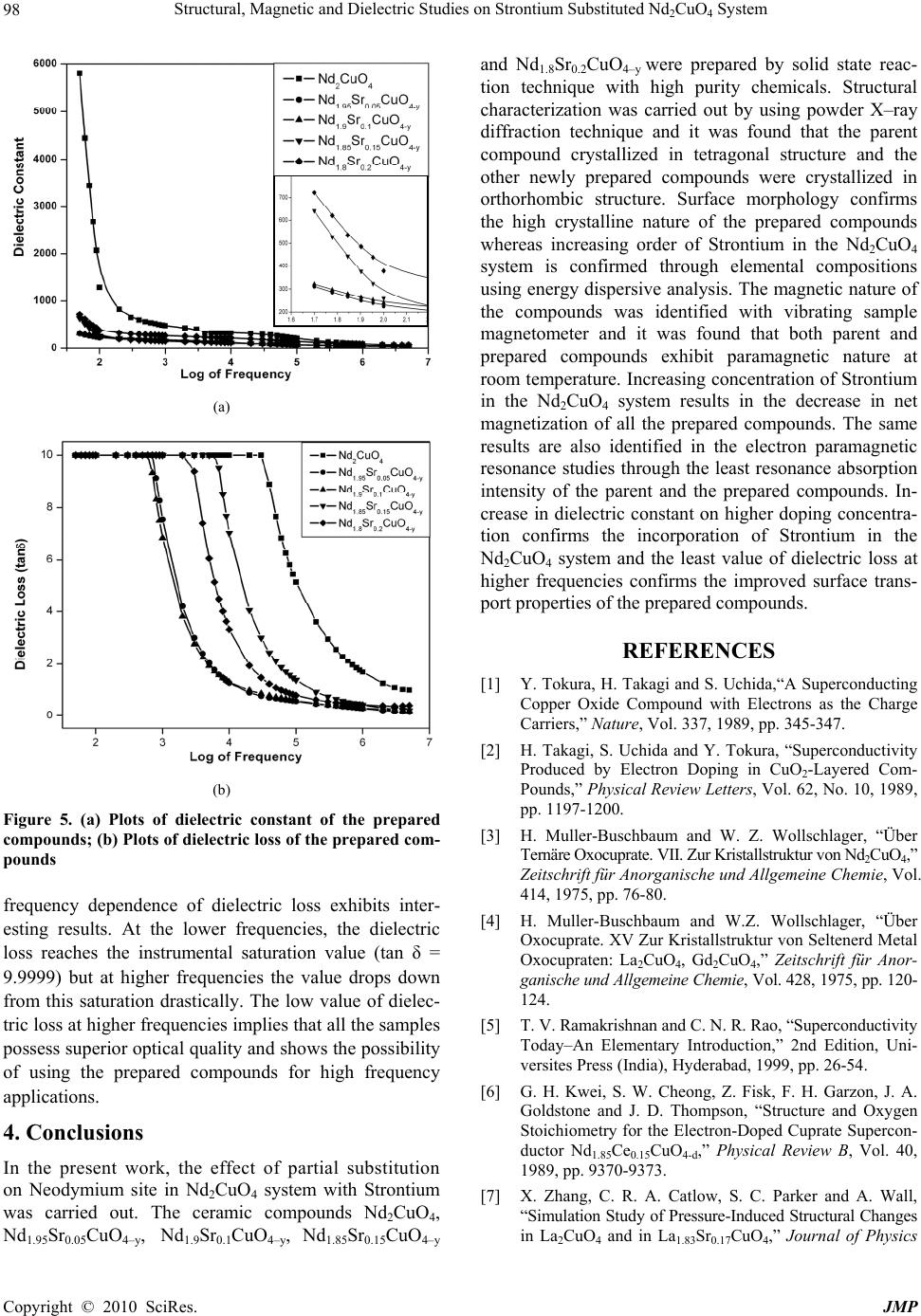 Structural, Magnetic and Dielectric Studies on Strontium Substituted Nd2CuO4 System Copyright © 2010 SciRes. JMP 98 (a) (b) Figure 5. (a) Plots of dielectric constant of the prepared compounds; (b) Plots of dielectric loss of the prepared com- pounds frequency dependence of dielectric loss exhibits inter- esting results. At the lower frequencies, the dielectric loss reaches the instrumental saturation value (tan δ = 9.9999) but at higher frequencies the value drops down from this saturation drastically. The low value of dielec- tric loss at higher frequencies implies that all the samples possess superior optical quality and shows the possibility of using the prepared compounds for high frequency applications. 4. Conclusions In the present work, the effect of partial substitution on Neodymium site in Nd2CuO4 system with Strontium was carried out. The ceramic compounds Nd2CuO4, Nd1.95Sr0.05CuO4–y, Nd1.9Sr0.1CuO4–y, Nd1.85Sr0.15CuO4–y and Nd1.8Sr0.2CuO4–y were prepared by solid state reac- tion technique with high purity chemicals. Structural characterization was carried out by using powder X–ray diffraction technique and it was found that the parent compound crystallized in tetragonal structure and the other newly prepared compounds were crystallized in orthorhombic structure. Surface morphology confirms the high crystalline nature of the prepared compounds whereas increasing order of Strontium in the Nd2CuO4 system is confirmed through elemental compositions using energy dispersive analysis. The magnetic nature of the compounds was identified with vibrating sample magnetometer and it was found that both parent and prepared compounds exhibit paramagnetic nature at room temperature. Increasing concentration of Strontium in the Nd2CuO4 system results in the decrease in net magnetization of all the prepared compounds. The same results are also identified in the electron paramagnetic resonance studies through the least resonance absorption intensity of the parent and the prepared compounds. In- crease in dielectric constant on higher doping concentra- tion confirms the incorporation of Strontium in the Nd2CuO4 system and the least value of dielectric loss at higher frequencies confirms the improved surface trans- port properties of the prepared compounds. REFERENCES [1] Y. Tokura, H. Takagi and S. Uchida,“A Superconducting Copper Oxide Compound with Electrons as the Charge Carriers,” Nature, Vol. 337, 1989, pp. 345-347. [2] H. Takagi, S. Uchida and Y. Tokura, “Superconductivity Produced by Electron Doping in CuO2-Layered Com- Pounds,” Physical Review Letters, Vol. 62, No. 10, 1989, pp. 1197-1200. [3] H. Muller-Buschbaum and W. Z. Wollschlager, “Über Ternäre Oxocuprate. VII. Zur Kristallstruktur von Nd2CuO4,” Zeitschrift für Anorganische und Allgemeine Chemie, Vol. 414, 1975, pp. 76-80. [4] H. Muller-Buschbaum and W.Z. Wollschlager, “Über Oxocuprate. XV Zur Kristallstruktur von Seltenerd Metal Oxocupraten: La2CuO4, Gd2CuO4,” Zeitschrift für Anor- ganische und Allgemeine Chemie, Vol. 428, 1975, pp. 120- 124. [5] T. V. Ramakrishnan and C. N. R. Rao, “Superconductivity Today–An Elementary Introduction,” 2nd Edition, Uni- versites Press (India), Hyderabad, 1999, pp. 26-54. [6] G. H. Kwei, S. W. Cheong, Z. Fisk, F. H. Garzon, J. A. Goldstone and J. D. Thompson, “Structure and Oxygen Stoichiometry for the Electron-Doped Cuprate Supercon- ductor Nd1.85Ce0.15CuO4-d,” Physical Review B, Vol. 40, 1989, pp. 9370-9373. [7] X. Zhang, C. R. A. Catlow, S. C. Parker and A. Wall, “Simulation Study of Pressure-Induced Structural Changes in La2CuO4 and in La1.83Sr0.17CuO4,” Journal of Physics 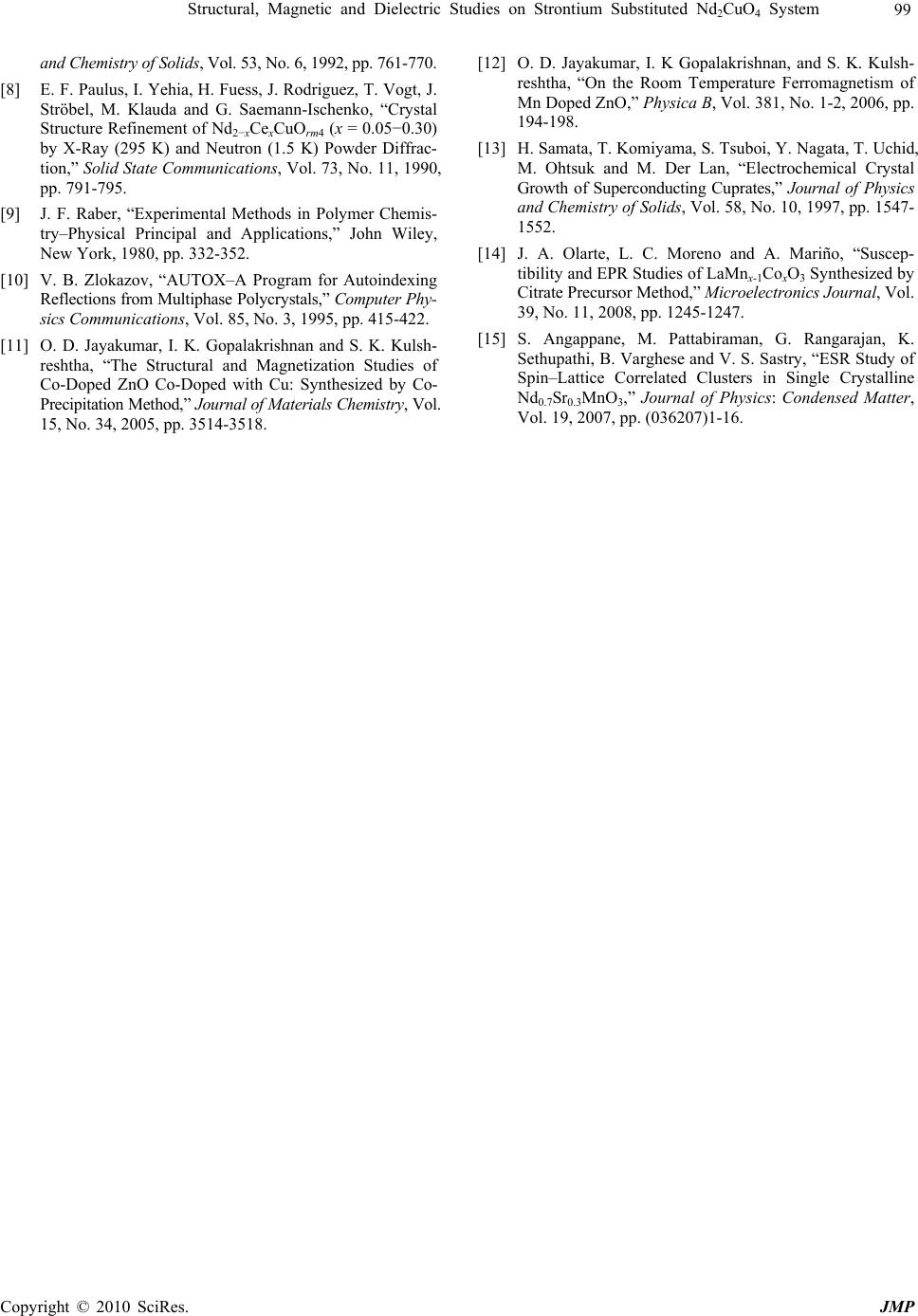 Structural, Magnetic and Dielectric Studies on Strontium Substituted Nd2CuO4 System Copyright © 2010 SciRes. JMP 99 and Chemistry of Solids, Vol. 53, No. 6, 1992, pp. 761-770. [8] E. F. Paulus, I. Yehia, H. Fuess, J. Rodriguez, T. Vogt, J. Ströbel, M. Klauda and G. Saemann-Ischenko, “Crystal Structure Refinement of Nd2−xCexCuOrm4 (x = 0.05−0.30) by X-Ray (295 K) and Neutron (1.5 K) Powder Diffrac- tion,” Solid State Communications, Vol. 73, No. 11, 1990, pp. 791-795. [9] J. F. Raber, “Experimental Methods in Polymer Chemis- try–Physical Principal and Applications,” John Wiley, New York, 1980, pp. 332-352. [10] V. B. Zlokazov, “AUTOX–A Program for Autoindexing Reflections from Multiphase Polycrystals,” Computer Phy- sics Communications, Vol. 85, No. 3, 1995, pp. 415-422. [11] O. D. Jayakumar, I. K. Gopalakrishnan and S. K. Kulsh- reshtha, “The Structural and Magnetization Studies of Co-Doped ZnO Co-Doped with Cu: Synthesized by Co- Precipitation Method,” Journal of Materials Chemistry, Vol. 15, No. 34, 2005, pp. 3514-3518. [12] O. D. Jayakumar, I. K Gopalakrishnan, and S. K. Kulsh- reshtha, “On the Room Temperature Ferromagnetism of Mn Doped ZnO,” Physica B, Vol. 381, No. 1-2, 2006, pp. 194-198. [13] H. Samata, T. Komiyama, S. Tsuboi, Y. Nagata, T. Uchid, M. Ohtsuk and M. Der Lan, “Electrochemical Crystal Growth of Superconducting Cuprates,” Journal of Physics and Chemistry of Solids, Vol. 58, No. 10, 1997, pp. 1547- 1552. [14] J. A. Olarte, L. C. Moreno and A. Mariño, “Suscep- tibility and EPR Studies of LaMnx-1CoxO3 Synthesized by Citrate Precursor Method,” Microelectronics Journal, Vol. 39, No. 11, 2008, pp. 1245-1247. [15] S. Angappane, M. Pattabiraman, G. Rangarajan, K. Sethupathi, B. Varghese and V. S. Sastry, “ESR Study of Spin–Lattice Correlated Clusters in Single Crystalline Nd0.7Sr0.3MnO3,” Journal of Physics: Condensed Matter, Vol. 19, 2007, pp. (036207)1-16. |

